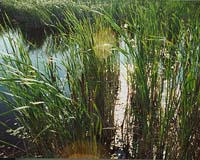| . |  |
. |
New York NY (SPX) Jul 16, 2009 The Wildlife Conservation Society has announced that critically endangered alligators in China have a new chance for survival. The WCS's Bronx Zoo, in partnership with two other North American parks and the Department of Wildlife Conservation and Management of the State Forestry Administration of China, has successfully reintroduced alligators into the wild that are now multiplying on their own. The alligator hatchlings-15 in number-are the offspring of a group of alligators that includes animals from the Wildlife Conservation Society's Bronx Zoo. The baby alligators represent a milestone for the 10-year effort to reintroduce the Chinese alligator on Chongming Island, located at the mouth of China's Yangtze River. "We are grateful to our Chinese partners for their commitment to reintroduce Chinese alligators back into the wild," said Dr. Steven E. Sanderson, President and CEO of the Wildlife Conservation Society. "WCS has championed careful wildlife reintroductions for more than a century. The reintroduction of Chinese alligators is a great example of how WCS partners with governments and local communities around the world to save wildlife and wild places." "This is fantastic news," said WCS researcher Dr. John Thorbjarnarson, one of the world's foremost experts on crocodilians and a participant in the project. "The success of this small population suggests that there's hope for bringing the Chinese alligator back to some parts of its former distribution." Plans to reintroduce Chinese alligators started in 1999 with a survey conducted by WCS, the Anhui Forestry Bureau, and the East China Normal University in Anhui Province, the only remaining location where the reptiles are still found in the wild in what is a small fraction of the alligator's former range. The results of the survey were dire, with an estimate of fewer than 130 animals in a declining population. An international workshop on the species was held in 2001, followed by recommendations for the reintroduction of captive bred alligators. The first three animals released in Hongxing Reserve of Xuancheng County in Anhui in 2003 were from the Anhui Research Center of Chinese Alligator Reproduction (ARCCAR). To ensure the maximum genetic diversity for the effort, project participants imported 12 more animals to Changxing Yinjiabian Chinese Alligator Nature Reserve from North America, including four from the Bronx Zoo. From this group, three animals from the U.S. were released in 2007 along with three more alligators from Changxing. The alligators were given health examinations by veterinary professionals from WCS's Global Health Program and the Shanghai Wildlife Zoo and fitted with radio transmitters for remote monitoring before being released. Experts reported that the reintroduced alligators successfully hibernated, and then in 2008, bred in the wild. With a former range that covered a wide watershed area of East China, the Chinese alligator-or "tu long," which means "muddy dragon"-is now listed as "Critically Endangered" on IUCN's Red List of Threatened Species and is the most threatened of the 23 species of crocodilians in the world today. It is one of only two alligator species in existence (the other is the better known, and much better off, American alligator). The Yangtze River, where the reintroduction of these alligators took place, is the third longest river in the world (after the Amazon and the Nile) and is China's most economically important waterway. The world's largest hydro-electric dam-the Three Gorges Dam-is also located on the river. The high levels of development along the river have become a challenge for native wildlife; in 2006, a comprehensive search for the Yangtze River dolphin, or baiji, didn't find any, although one isolated sighting of a dolphin was made in 2007. Share This Article With Planet Earth
Related Links Wildlife Conservation Society Darwin Today At TerraDaily.com
 EU report seeks action on biodiversity
EU report seeks action on biodiversityBrussels (UPI) Jul 15, 2009 The EU environment commissioner warned action is needed to save species and habitat types the have been placed under EU legal protection. Environment Commissioner Stavros Dimas, in a release issued Monday, said the overall tenor of the report on conservation status indicates habitats and species "have not achieved good conservation status." He added, however, protection steps are ... read more |
|
| The content herein, unless otherwise known to be public domain, are Copyright 1995-2009 - SpaceDaily. AFP and UPI Wire Stories are copyright Agence France-Presse and United Press International. ESA Portal Reports are copyright European Space Agency. All NASA sourced material is public domain. Additional copyrights may apply in whole or part to other bona fide parties. Advertising does not imply endorsement,agreement or approval of any opinions, statements or information provided by SpaceDaily on any Web page published or hosted by SpaceDaily. Privacy Statement |